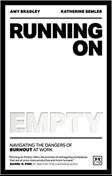- Behaviour
Causes and Cures of Burnout
Amy Bradley and Katherine Semler suggest steps to mitigate overwhelm and burnout at work
Gone or going but hopefully not forgotten—as these twin scourges offer some salutary lessons for line managers, individuals and HR professionals.

With the pandemic acting as a catalyst, people from many industry sectors resigned or quit 'going the extra mile' to a large extent because working practices and workplace cultures were not conducive to job satisfaction, wellbeing, or a healthy work/life balance. This now needs to be addressed, not only to avoid resignations, but to improve the wellbeing, happiness, and consequently the performance of all employees.
For many people difficult or hostile working environments, along with the way they personally approach and experience work, can lead to feelings of being overwhelmed and to ‘burnout’. The always-on, hyper-connected, digitally-enhanced modern way of working, where the boundaries of work and private life can be blurred, may be efficient in many ways but can too easily push people into workaholism and over-extension. Burnout is on the rise and should be acknowledged and dealt with both by individuals and employers.
Having just watched the devastating Oscar winning film All Quiet on the Western Front, the concerns of workers in our individualistic, entitled times may seem insignificant. Yet the functioning of our economies and our ability to address today’s multiple social and environmental challenges depends on the performance of workers and their leaders—if they are stymied by overwhelm and burnout this is a threat to all of us.
In their research-based book, Running on Empty: Navigating the Dangers of Burnout at Work, Amy Bradley and Katherine Sembler explore the root causes of burnout and its negative consequences. While not offering a panacea, they suggest ways organizations can improve the human experience of their workforce and ways individuals can see the warning signs of burnout and learn how to avoid it.
The core message of the book—illustrated through a series of individual personal stories—is that the causes of burnout are complex and nuanced, yet always depend on the interplay between an individual’s personality, their work context and workplace culture, and the circumstances going on in their personal lives. By presenting in-depth stories of several individuals’ experience of overwhelm and burnout the book astutely shows how the personal and the organizational dynamics relate.
From the employer’s perspective the challenge is to create more humane working environments and to be aware of the signs of burnout so as to offer support. Burnout comes when there is a mismatch between human nature and the nature of the job. It is in the nature of people to crave control, to feel a sense of agency, and to know their contribution is appreciated. For the individual, who spends so much of his or her time working, it is important not to be defined by work. One’s sense of self-worth should rely on far more than just one's role at work.
Defining the size of the challenge, the authors quote a study that found three out of five workers across the world feel burned out, and another that claims that the figure is in fact three in four. The UK’s Royal College of General Practitioners reports that four in ten doctors in England are likely to leave the profession within the next five years—largely due to perceived imminent burnout.
It is important that organizations take account of the danger of employee burnout in their efforts to create better more productive workplaces and that employees noticing the signs of imminent burnout take action to avoid it. Bradley and Sembler’s book provides valuable insight and, although not offering an instant cure, points to things individuals and employers should avoid and actions they should take.
About the authors
Dr Amy Bradley specializes in compassionate leadership, burnout and engagement at work, and is author of The Human Moment (LID). She is Professor of Leadership and Management at Hult International Business School, where she holds a post of Professor in Leadership and Management. She lives in the UK.
Katherine Semler is a partner at Korn Ferry Hay Group in Spain and specializes in leadership development. She was previously an executive in corporate learning and programme design at Telefonica University and IESE Business School. She is based in Barcelona.
……………………………………………………………………………………………………………………
Hult Ashridge Executive Education helps organizations around the world improve their leadership talent, strategic thinking and organizational culture.
ARTICLES YOU MIGHT LIKE
RESEARCH
LBS and ESMT study identifies the danger of citing information based on the ‘gist’ of the truth rather than the ‘literal’ truth
DEVELOPING LEADERS QUARTERLY MAGAZINE AND WEEKLY BRIEFING EMAILS


































